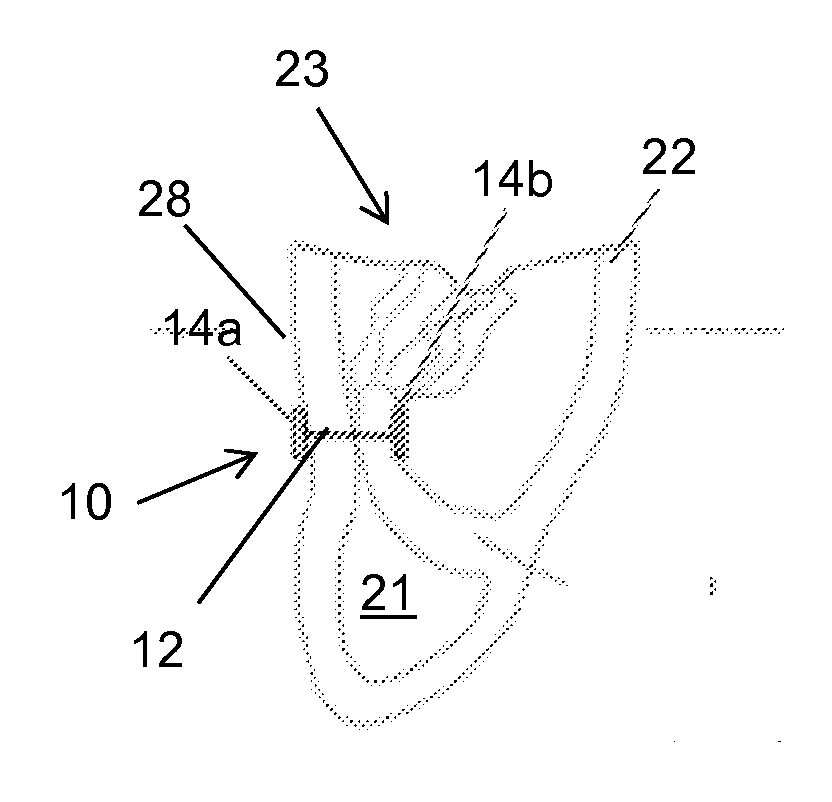Right ventricular papillary approximation
- Summary
- Abstract
- Description
- Claims
- Application Information
AI Technical Summary
Benefits of technology
Problems solved by technology
Method used
Image
Examples
example 1
Ex Vivo Use of Right Ventricular Papillary Approximation as Treatment for Tricuspid Regurgitation
[0108]To evaluate the techniques described herein, right ventricular papillary approximation was performed on an experimentally produced tricuspid regurgitation and compared to a tricuspid annuloplasty.
[0109]Right ventricles of isolated porcine hearts (n=10) were statically pressurized (44 mmHg) in a saline-filled tank, leading to right ventricle dilation and central tricuspid regurgitation. Tricuspid regurgitant flow in a right ventricle was measured with a saline-filled column connected to the saline-filled tank 104 in which the right ventricle was immersed.
[0110]Referring to FIG. 21A, for a right ventricular papillary approximation treatment, the head of the anterior papillary muscle 24 was approximated to four sites on the ventricular septum 28 between the medial 27 and posterior 29 papillary muscles: the medial papillary muscle (site A-M), the posterior papillary muscle (site A-P), ...
example 2
In Vivo Use of Right Ventricular Papillary Muscle Approximation as Treatment for Tricuspid Regurgitation
[0117]Right ventricular papillary approximation was performed and compared to a tricuspid annuloplasty using in vivo swine chronic model for validation of the results of the ex vivo example described above.
[0118]Tricuspid regurgitation was created in swines (n=5, 50.0±1.3 kg) with beating hearts by annular incisions using a cardioport video-assisted imaging system through thoracotomy. Four to five weeks after the creation of the tricuspid regurgitation, the swines underwent right ventricular papillary approximation or tricuspid annuloplasty on cardiopulmonary bypass via midsternal incision. As shown in FIG. 25A, the anterior papillary muscle 24 of the right ventricle 21 was approximated to the ventricular septum 28 with sutures 506 with pledgets 508. The direction of papillary approximation was A-S1 (i.e., anterior papillary muscle 24 to the midpoint of the medial and posterior pa...
example 3
Force Tolerated by Fixation Mechanism
[0122]An experiment was conducted to evaluate the amount of force a two-membrane umbrella (e.g., umbrella 62) can tolerate. Referring to FIG. 29A, a hole 902 was made through fresh myocardium 900 of ventricular septum and a device 904 including an umbrella 62 at its distal end was introduced into the hole. The size of the hole was changed from 8-16 Fr and the force that the umbrella 62 was able to tolerate (i.e., the force that could be applied before the device detached from the septum) was measured.
[0123]The measured force is shown in a graph 908 of FIG. 29B. The forces applied at the umbrella 62 are about 2.5-3 N, regardless of the size of the hole 902. In some cases, a diseased heart, such as a heart with right ventricular failure or pulmonary hypertension, may exert forces greater than 2.5-3 N.
[0124]Referring to FIG. 30, a reinforced umbrella tip 910 was fabricated to improve its strength. The umbrella tip 910 was anchored with crimping part...
PUM
 Login to View More
Login to View More Abstract
Description
Claims
Application Information
 Login to View More
Login to View More - R&D
- Intellectual Property
- Life Sciences
- Materials
- Tech Scout
- Unparalleled Data Quality
- Higher Quality Content
- 60% Fewer Hallucinations
Browse by: Latest US Patents, China's latest patents, Technical Efficacy Thesaurus, Application Domain, Technology Topic, Popular Technical Reports.
© 2025 PatSnap. All rights reserved.Legal|Privacy policy|Modern Slavery Act Transparency Statement|Sitemap|About US| Contact US: help@patsnap.com



